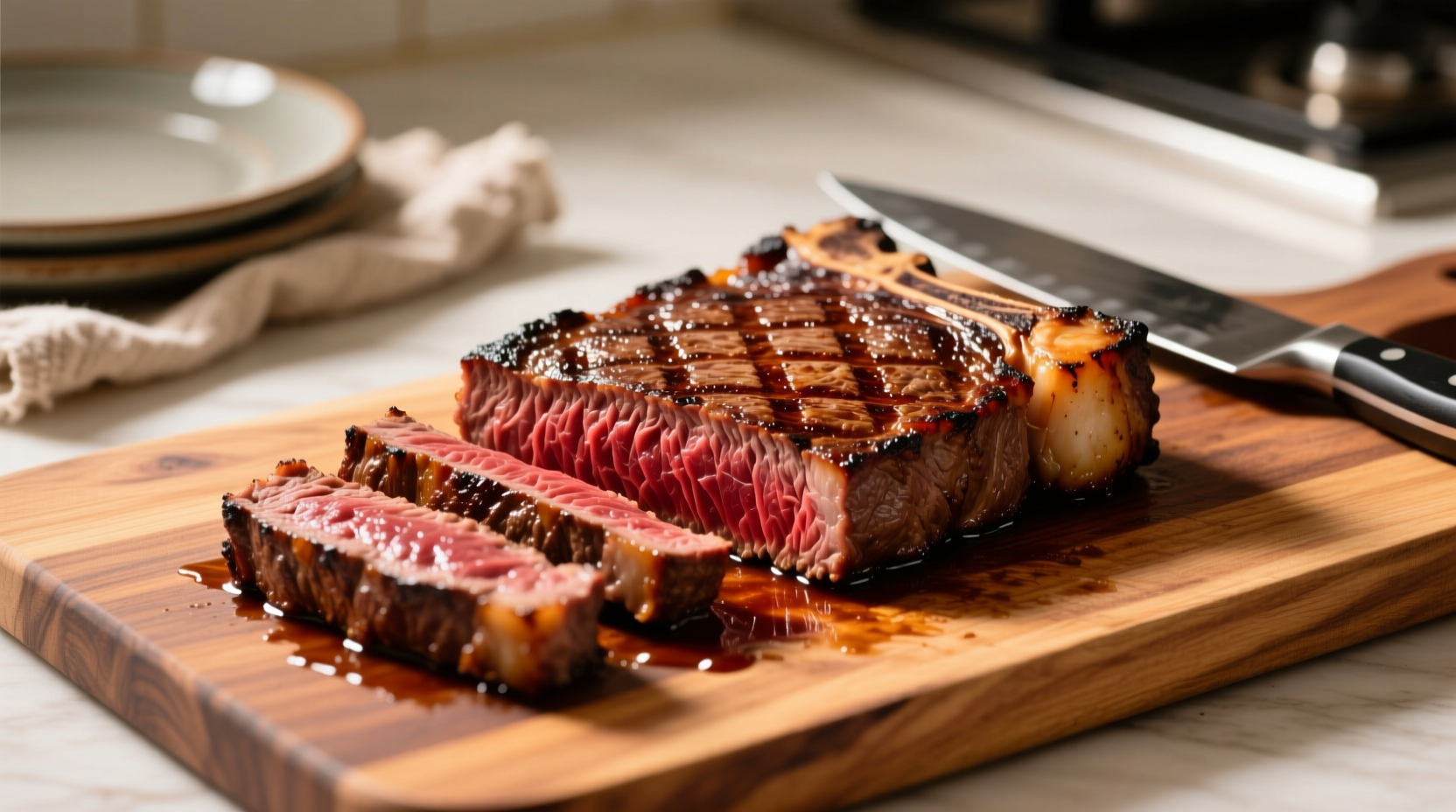Why Indoor Flank Steak Cooking Works
Flank steak's intense beefy flavor and lean composition make it ideal for high-heat indoor cooking methods. Unlike thicker cuts, its relatively thin profile (typically 1-1.5 inches thick) allows quick searing while preventing overcooking. The key is replicating the grill's intense direct heat through alternative techniques that trigger the Maillard reaction—the chemical process creating that desirable browned crust and complex flavors.
Essential Preparation Steps
Proper preparation makes or breaks your indoor flank steak experience. Follow these critical steps before cooking:
Selection and Thawing
Choose bright red flank steak with minimal connective tissue. Thaw frozen steak in the refrigerator for 24 hours—never at room temperature—to maintain food safety. Pat completely dry with paper towels; moisture prevents proper searing.
Marinating Fundamentals
Flank steak benefits from acidic marinades that help tenderize its dense muscle fibers. Combine these elements:
- 1/4 cup acid (red wine vinegar, citrus juice, or Worcestershire sauce)
- 2 tablespoons oil (avocado or canola)
- 2 minced garlic cloves
- 1 tablespoon soy sauce
- 1 teaspoon black pepper
Marinate for 4-12 hours—never exceed 24 hours as acid can make meat mushy. Always marinate in the refrigerator.
Cooking Method 1: Stovetop Skillet (Most Accessible)
This technique delivers exceptional results with minimal equipment. You'll need a heavy-bottomed cast iron or stainless steel skillet.
Step-by-Step Process
- Preheat skillet over medium-high heat for 5 minutes until smoking slightly
- Season steak with 1 teaspoon kosher salt per side
- Place steak in skillet, pressing gently for full contact
- Cook 4-6 minutes per side for medium-rare (130-135°F internal temperature)
- Flip only once—frequent flipping prevents proper crust formation
- During last 2 minutes, add 2 tablespoons butter, 2 garlic cloves, and rosemary sprig; tilt pan and spoon melted butter over steak
- Transfer to cutting board and rest 8-10 minutes before slicing
Visual Doneness Cues
Use these visual indicators alongside thermometer readings:
- Rare: Deep red center, very soft to touch
- Medium-rare: Warm red center, soft with slight resistance
- Medium: Pink center, firm but yielding

Cooking Method 2: Broiler (Closest to Grilling)
The broiler's intense top-down heat mimics grill flames. Position oven rack 5-6 inches from heat source.
Optimal Broiling Technique
- Preheat broiler on high for 15 minutes
- Place seasoned steak on wire rack set over baking sheet
- Broil 6-8 minutes per side for medium-rare
- Rotate steak 180 degrees halfway through each side for even cooking
- Check temperature frequently during last few minutes
| Cooking Method | Prep Time | Cook Time | Equipment Needed | Best For |
|---|---|---|---|---|
| Stovetop Skillet | 15 min | 10-12 min | Cast iron skillet | Quick weeknight meals |
| Broiler | 20 min | 12-16 min | Oven broiler | Grill-like char without outdoor space |
| Oven Roasting | 15 min | 15-20 min | Rimmed baking sheet | Larger quantities or precise temperature control |
Critical Slicing Technique
Flank steak's long muscle fibers require specific slicing to ensure tenderness. This step transforms potentially chewy meat into melt-in-your-mouth perfection:
Proper Slicing Method
- Identify the grain direction (parallel muscle fibers)
- Position knife perpendicular to grain at 65-75 degree angle
- Cut thin slices (1/4-1/2 inch thick) against the grain
- Use a sharp chef's knife—dull blades tear meat fibers
According to the USDA Food Safety and Inspection Service, cooking flank steak to the proper internal temperature (130-135°F for medium-rare) followed by adequate resting time allows proteins to reabsorb juices, preventing dryness when sliced.
Troubleshooting Common Issues
Tough Steak Solutions
If your flank steak turns out tough, consider these fixes:
- Overcooked steak: Slice thinner and serve with flavorful sauce (chimichurri works perfectly)
- Under-marinated: Serve with acidic salsa or vinaigrette to help tenderize
- Incorrect slicing: Reposition cutting board to slice perpendicular to the grain
Flavor Enhancement Tips
Elevate your indoor-cooked flank steak with these professional techniques:
- After searing, add 1/4 cup beef stock to deglaze the pan, creating an instant pan sauce
- Finish with flaky sea salt and fresh herbs just before serving
- Let sliced steak rest 2 minutes on warm plate before serving to redistribute juices
When to Choose Each Cooking Method
Understanding context boundaries ensures optimal results:
Stovetop Skillet Best For
- Weeknight dinners with time constraints
- Smaller kitchens without oven access
- Cooking just 1-2 servings
Broiler Best For
- Mimicking grill char without outdoor space
- Cooking larger quantities (3+ servings)
- When outdoor grilling isn't possible due to weather
Oven Roasting Best For
- More precise temperature control
- Cooking multiple steaks simultaneously
- When stove space is limited during holiday meals
Resting Timeline: Why It Matters
Resting allows muscle fibers to reabsorb juices that would otherwise spill out when sliced. Follow this timeline for perfect results:
- 0-2 minutes: Juices begin redistributing through meat
- 3-5 minutes: Temperature evens throughout steak
- 6-8 minutes: Optimal window for medium-rare flank steak
- 9+ minutes: Steak continues cooking from residual heat (risk of overcooking)
Research from the USDA National Institute of Food and Agriculture confirms that resting meat for 5-10 minutes after cooking improves juiciness by up to 30% compared to immediate slicing.
Final Pro Tips
- Always use an instant-read thermometer—guessing leads to overcooked steak
- Room temperature steak cooks more evenly than cold steak
- Don't overcrowd the pan—cook in batches if necessary
- Reserve 2 tablespoons of marinade (before adding steak) for finishing sauce











 浙公网安备
33010002000092号
浙公网安备
33010002000092号 浙B2-20120091-4
浙B2-20120091-4